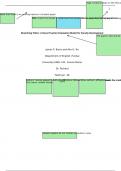Page numbers begin on the first p
1
Note that there is no running head on a student paper.
Note: Green text boxes contain
...while explanations of APA
blue text boxes 7's paper
contain formatting
directions guidelines...
for writing and citing
Branching Paths: A Novel Teacher Evaluation Model for Faculty Development
The paper's title should
James P. Bavis and Ahn G. Nu
Department of English, Purdue
University ENGL 101: Course Name
Dr. Richard
Teeth Jan. 30,
Authors' names appear two lines below
Authors' the title.
affiliations They
follow should be written
immediately
Follow after
authors' as follows:
their names.
affiliations For numb
with the stude
2020
First name, middle initial(s), last name.
Student papers do not contain an author's note.
,Note again that no running head appears on student papers. Note that the page number continues on the pag
2
The word "Abstract" should be centered and bolded at the top of the page.
Abstract
The main paragraph
A largeofbody
the abstract should not
of assessment be indented.
literature suggests that students’ evaluations of their
teachers (SETs) can fail to measure the construct of teaching in a variety of
contexts. This can compromise faculty development efforts that rely on information
from SETs. The disconnect between SET results and faculty development efforts is
By standar
exacerbated in educational contexts that demand particular teaching skills that
SETs do not value in proportion to their local importance (or do not measure at all).
This paper responds to these challenges by proposing an instrument for the
assessment of teaching that allows institutional stakeholders to define the teaching
construct in a way they determine to suit the local context. The main innovation of
this instrument relative to traditional SETs is that it employs a branching “tree”
structure populated by binary-choice items based on the Empirically derived,
Binary-choice, Boundary-definition (EBB) scale developed by Turner and Upshur for
ESL writing assessment. The paper argues that this structure can allow
stakeholders to define the teaching construct by changing the order and sensitivity
of the nodes in the tree of possible outcomes, each of which corresponds to a
specific teaching skill. The paper concludes by outlining a pilot study that will
examine the differences between the proposed EBB instrument and a traditional
SET employing series of multiple-choice questions (MCQs) that correspond to Likert
An abstract quickly summarizes the main points of the paper that follows it. The APA 7 manual does not give explicit
scale values.
Keywords: college teaching, student evaluations of teaching, scale
development, EBB
scale, pedagogies, educational assessment, faculty development
Follow the abstract with a selection of keywords that describe the imp
The keyword list should have its first line indented. Begin the list with
Note: Past this point, the student p
, The
Here, we've borrowed a quote from an external source, so we paper's
need title isthe
to provide bolded and centered
location above
of the quote thedocume
in the first bo
3
Branching Paths: A Novel Teacher Evaluation Model for Faculty Development
According to Theall (2017), “Faculty evaluation and development cannot be
considered separately ... evaluation without development is punitive, and
development without evaluation is guesswork" (p. 91). As the practices that
constitute modern programmatic faculty development have evolved from their
humble beginnings to become a commonplace feature of university life (Lewis,
By contrast, here, we've merely paraphrased an idea from the external source. Thus, no location or page number is re
1996), a variety of tactics to evaluate the proficiency of teaching faculty for Spell out a
"CIA").
development purposes have likewise become commonplace. These include
measures as diverse as peer observations, the development of teaching portfolios,
and student evaluations.
One such measure, the student evaluation of teacher (SET), has been
virtually ubiquitous since at least the 1990s (Wilson, 1998). Though records of SET-
For source
like instruments can be traced to work at Purdue University in the 1920s (Remmers
& Brandenburg, 1927), most modern histories of faculty development suggest that
their rise to widespread popularity went hand-in-hand with the birth of modern
faculty development programs in the 1970s, when universities began to adopt
them in response to student protest movements criticizing mainstream university
When listin
curricula and approaches to instruction (Gaff & Simpson, 1994; Lewis, 1996;
McKeachie, 1996). By the mid-2000s, researchers had begun to characterize SETs
in terms like “…the predominant measure of university teacher performance […]
worldwide” (Pounder, 2007, p. 178). Today, SETs play an important role in teacher
assessment and faculty development at most universities (Davis, 2009). Recent
SET research practically takes the presence of some form of this assessment on
most campuses as a given. Spooren et al. (2017), for instance, merely note that
that SETs can be found at “almost every institution of higher education throughout
the world” (p. 130). Similarly, Darwin (2012) refers to teacher evaluation as an
established orthodoxy, labeling it a “venerated,” “axiomatic” institutional practice
(p. 733).
, 4
Moreover, SETs do not only help universities direct their faculty development
efforts.
They have also come to occupy a place of considerable institutional importance for
their role in




